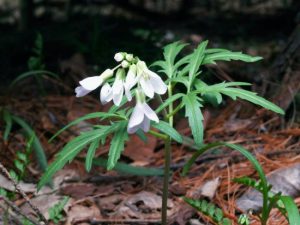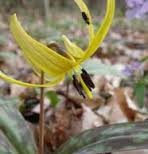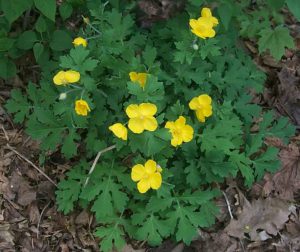After a long winter it is always a welcome sight when the Spring native plants awaken, make their way through the leaf litter, and eventually bloom. In the native woodland area of the Hancock County Extension office grounds, we are seeing signs that Spring is here. This small area along a fence line with several mature trees has been the home of some interesting native plants for over ten years. The planting of this area was done by a couple past Master Gardeners and, as the plants have matured, it’s a pleasant place to be on a spring day. Let’s take a look at just a few of the species that are included in the area and their growing requirements. While Mother Nature is the ultimate landscaper, you can create some beauty in even a small wooded area of your landscape.
 Cutleaf Toothwort (Dentaria luciniata)
Cutleaf Toothwort (Dentaria luciniata)
This plant is considered a spring ephemeral (plants that flower in Spring and then go dormant for Summer). It grows 8-16 inches tall and blooms in early spring. Light requirements are partial to full shade. It spreads well on its own in rich humus soil but can be propagated by sowing seeds when they are fresh or by dividing the rhizomes. Plant the rhizomes horizontally 2 to 3 inches deep and mulch. It requires adequate moisture but not wet soil. Grows well with Trout Lily.
 Trout Lily (Erythronium americanum)
Trout Lily (Erythronium americanum)
Another spring ephemeral, Trout lily grows 4-10 inches tall and blooms in early spring. It likes shade to filtered sun. It also is known as adder’s tongue and dogtooth violet. This plant can be started from fresh seed but can take years to flower (usually 7-8 years). You will get flowering sooner by dividing root offshoots in the fall (be sure to mark the lily in the spring before it goes dormant). Plant the offshoots or bulbs 3 to 5 inches deep. Bulbs delve deeper as they mature. It requires rich woodland soil, slightly acidic to neutral (pH 5-6). Dig in lots of compost when planting. It tolerates moist to dry conditions.
 Wood Poppy (Stylophorum dyphyllum)
Wood Poppy (Stylophorum dyphyllum)
Sometimes referred to as Celandine Poppy. (Do not confuse it with a non-native and invasive known as Lesser Celandine (Chelidonium majus). This plant grows 1-1.5 feet tall. Light requirements are shade to partial shade. It blooms profusely in spring and may bloom with less frequency during the summer if grown in a reasonably damp area. It self-sows readily but can be divided in spring or fall. Plant rhizomes with the “eye” 1 inch below soil level and mulch. Wood Poppy likes soil on the moist side. It requires little care except for occasional mulching and adding compost to regenerate the soil.
 Wild Ginger (Asarum canadense)
Wild Ginger (Asarum canadense)
Wild Ginger is a ground cover about 6 inches tall. It prefers full to partial shade. It’s flower is found beneath the foliage. The seeds can be planted in early to mid summer while still fresh or the rhizomes can be planted horizontally about ½ inch deep. It self-sows readily. Rich, neutral to slightly acidic (pH 5.5 to 6.5) soil is preferred by the plant. Otherwise, it needs little care.